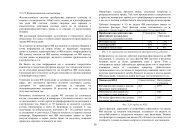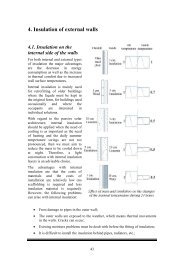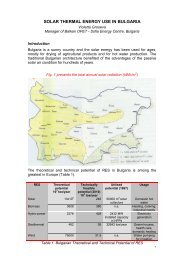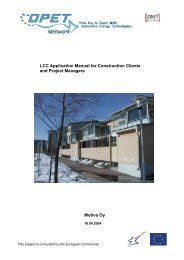Guidebook for Energy Efficiency in Municipalities
Guidebook for Energy Efficiency in Municipalities
Guidebook for Energy Efficiency in Municipalities
Create successful ePaper yourself
Turn your PDF publications into a flip-book with our unique Google optimized e-Paper software.
<strong>Energy</strong> plann<strong>in</strong>g concept versus s<strong>in</strong>gle actions<br />
A4<br />
There are different levels on which the energy relevant activities can be planned and<br />
implemented. On the one hand, there are comprehensive energy plann<strong>in</strong>g concepts<br />
(energy management action plans), which usually <strong>in</strong>clude the follow<strong>in</strong>g parts:<br />
well def<strong>in</strong>ed objectives,<br />
analysis of the current situation,<br />
analysis of possible measures and scenarios,<br />
def<strong>in</strong>ition of actions and projects,<br />
implementation and evaluation.<br />
Depend<strong>in</strong>g on the scope and degree of details, the literature differs between simple or<br />
standard energy plann<strong>in</strong>g concepts, climate protection plans, and programs <strong>for</strong><br />
susta<strong>in</strong>ability, which are the most comprehensive ones.<br />
On the other hand, there is the possibility of implement<strong>in</strong>g s<strong>in</strong>gle measures that are not<br />
connected or embedded <strong>in</strong> a comprehensive energy plann<strong>in</strong>g concept. Experience has<br />
shown that often too much time and ef<strong>for</strong>t is spent <strong>in</strong> order to design a comprehensive,<br />
far-reach<strong>in</strong>g, and complete energy efficiency action plan. Hence, a strategy characterized<br />
by the motto: “courage <strong>for</strong> the gap” is preferred then.<br />
The idea is to identify and compare different measures only very rough without collect<strong>in</strong>g<br />
a pile of comprehensive data and without design<strong>in</strong>g a whole action plan. Rather only a<br />
s<strong>in</strong>gle measure can be selected and implemented as a s<strong>in</strong>gle project right away.<br />
<strong>Energy</strong> management as a cont<strong>in</strong>uous process<br />
It cannot be over-emphasized that energy management is a long-term commitment, not<br />
just someth<strong>in</strong>g that is carried out once and then passes through. If the energy manager<br />
has implemented the review stage of the action plan properly, then a plan of cont<strong>in</strong>uous<br />
improvement has already been <strong>in</strong>stituted. However, the need <strong>for</strong> cont<strong>in</strong>uous improvement<br />
is so overwhelm<strong>in</strong>g that it is presented separately here as well.<br />
Policy<br />
The <strong>Energy</strong> Manager should be <strong>in</strong>volved <strong>in</strong> all capital works that affect energy use. These<br />
works <strong>in</strong>clude:<br />
• Office refurbishment<br />
• New build<strong>in</strong>gs<br />
• Relocation to new premises<br />
• New equipment purchases<br />
• Ma<strong>in</strong>tenance<br />
• Operational decisions about the use of build<strong>in</strong>gs<br />
Each of these represents an opportunity to greatly improve efficiency at very little cost -<br />
or, on the other hand, a risk that a decision will be made that will significantly <strong>in</strong>crease<br />
energy costs. The energy manager should ensure that processes are established <strong>in</strong> order<br />
to be able to provide <strong>in</strong>put early <strong>in</strong> the decision mak<strong>in</strong>g process. The later the energy<br />
manager’s <strong>in</strong>volvement, the more likely it is that the decision will be treated as f<strong>in</strong>al,<br />
be<strong>for</strong>e he/she can change it.






